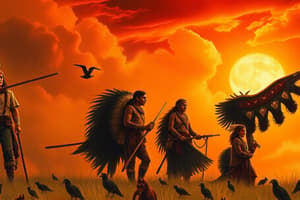Podcast
Questions and Answers
What was the primary aim of the Dawes Act of 1887?
What was the primary aim of the Dawes Act of 1887?
- To protect Indigenous cultural practices
- To encourage communal landownership
- To break up Indian communal lands into individual plots (correct)
- To promote tribal sovereignty
Which event exemplified Native American resistance against U.S. military expansion in the late 19th century?
Which event exemplified Native American resistance against U.S. military expansion in the late 19th century?
- Dawes Act resistance
- Curtis Act protests
- Wounded Knee Massacre
- Battle of Little Bighorn (correct)
What was a significant consequence of the Curtis Act of 1898?
What was a significant consequence of the Curtis Act of 1898?
- Weakened tribal governments (correct)
- Increased autonomy for Five Civilized Tribes
- Strengthening of tribal governments
- Expansion of Indigenous sovereignty
What type of educational institutions enforced strict policies to assimilate Native American children?
What type of educational institutions enforced strict policies to assimilate Native American children?
What was the federal government's approach towards Native American traditions during the post-Civil War era?
What was the federal government's approach towards Native American traditions during the post-Civil War era?
The Wounded Knee Massacre of 1890 illustrated what aspect of federal policy towards Native Americans?
The Wounded Knee Massacre of 1890 illustrated what aspect of federal policy towards Native Americans?
What was a major characteristic of federal policies towards Native Americans in the late 19th century?
What was a major characteristic of federal policies towards Native Americans in the late 19th century?
How did westward expansion in the post-Civil War era affect Indigenous peoples?
How did westward expansion in the post-Civil War era affect Indigenous peoples?
What significant study published in 1928 acknowledged the dire conditions in Native American communities?
What significant study published in 1928 acknowledged the dire conditions in Native American communities?
Which act, passed in 1934, reversed decades of allotment policies and supported tribal governance?
Which act, passed in 1934, reversed decades of allotment policies and supported tribal governance?
How many Native Americans served in World War II?
How many Native Americans served in World War II?
What was the primary goal of the Termination Policy introduced in the 1950s?
What was the primary goal of the Termination Policy introduced in the 1950s?
Which organization, founded in 1968, challenged federal authority and promoted Indigenous rights?
Which organization, founded in 1968, challenged federal authority and promoted Indigenous rights?
What major event occurred from 1969 to 1971 that drew national attention to Native American issues?
What major event occurred from 1969 to 1971 that drew national attention to Native American issues?
Which act passed in 1968 acknowledged certain constitutional protections for Indigenous peoples?
Which act passed in 1968 acknowledged certain constitutional protections for Indigenous peoples?
What did the Indian Self-Determination and Education Assistance Act of 1975 allow tribes to do?
What did the Indian Self-Determination and Education Assistance Act of 1975 allow tribes to do?
Which act, passed in 1988, authorized casinos on reservations?
Which act, passed in 1988, authorized casinos on reservations?
What overarching theme characterized Native American history from 1865 to 1991?
What overarching theme characterized Native American history from 1865 to 1991?
What was the effect of the federal policies after World War II on Native communities?
What was the effect of the federal policies after World War II on Native communities?
Which major Native American event in the 1970s underscored unresolved historic injustices?
Which major Native American event in the 1970s underscored unresolved historic injustices?
In what way did the Red Power Movement of the 1960s and 1970s impact public perception?
In what way did the Red Power Movement of the 1960s and 1970s impact public perception?
Flashcards
Dawes Act of 1887
Dawes Act of 1887
A U.S. law that divided Native American tribal lands into individual plots for non-Native settlement, aiming for assimilation.
Assimilation Policy
Assimilation Policy
Federal policies aimed at forcing Native Americans to adopt Euro-American culture, stripping them of their traditions, languages, and lands,.
Curtis Act of 1898
Curtis Act of 1898
A law that further weakened Native American tribal governments, particularly targeting the "Five Civilized Tribes"
Boarding Schools
Boarding Schools
Signup and view all the flashcards
Native American Resistance
Native American Resistance
Signup and view all the flashcards
Wounded Knee Massacre
Wounded Knee Massacre
Signup and view all the flashcards
Tribal Sovereignty
Tribal Sovereignty
Signup and view all the flashcards
Land Dispossession
Land Dispossession
Signup and view all the flashcards
Dawes Act Impact
Dawes Act Impact
Signup and view all the flashcards
Meriam Report
Meriam Report
Signup and view all the flashcards
Indian Reorganization Act (IRA)
Indian Reorganization Act (IRA)
Signup and view all the flashcards
World War I Native American Participation
World War I Native American Participation
Signup and view all the flashcards
World War II Native American Participation
World War II Native American Participation
Signup and view all the flashcards
Navajo Code Talkers
Navajo Code Talkers
Signup and view all the flashcards
Termination Policy
Termination Policy
Signup and view all the flashcards
Red Power Movement
Red Power Movement
Signup and view all the flashcards
Occupation of Alcatraz
Occupation of Alcatraz
Signup and view all the flashcards
Indian Civil Rights Act
Indian Civil Rights Act
Signup and view all the flashcards
Indian Self-Determination and Education Assistance Act
Indian Self-Determination and Education Assistance Act
Signup and view all the flashcards
Indian Gaming Regulatory Act
Indian Gaming Regulatory Act
Signup and view all the flashcards
Self-Determination
Self-Determination
Signup and view all the flashcards
Native American Activism
Native American Activism
Signup and view all the flashcards
Study Notes
Native American Civil Rights (1865-1991)
- Federal policies aimed to assimilate Native Americans and seize their land in the post-Civil War era (1865-1900)
- The Dawes Act (1887) divided tribal lands into individual plots, weakening communal ownership
- The Curtis Act (1898) further fragmented tribal governments
- Boarding schools, like Carlisle, enforced assimilation through English-only policies and cultural suppression
- Native resistance, like the Battle of Little Bighorn, challenged federal control
- The Wounded Knee Massacre (1890) exemplified the violence against Indigenous communities.
Early 20th Century (1900-1930s)
- Federal policies in the early 20th century maintained the goal of eroding tribal sovereignty.
- The Meriam Report (1928) exposed dire conditions in Native American communities, prompting a reevaluation of policies
- The Indian Reorganization Act (IRA) of 1934 reversed the allotment era, allowing for tribal self-governance and communal land ownership.
The World Wars (1917-1945)
- Native Americans served in both World Wars, highlighting their resilience
- Navajo Code Talkers played a crucial role in World War II
- Migration to urban areas increased, altering social structures and creating new challenges
Post-War and Civil Rights Era (1945-1970s)
- The Termination Policy (1950s) aimed to dissolve tribes and assimilate Native Americans into mainstream society
- Native American activism mirrored broader civil rights movements. The American Indian Movement (AIM) played a significant role
- Protests, like the Occupation of Alcatraz, the Trail of Broken Treaties, and the Wounded Knee standoff, highlighted demands for treaty rights, cultural preservation, and sovereignty.
- The Indian Civil Rights Act (1968) offered some constitutional protections, though enforcement proved inconsistent.
Modern Progress and Setbacks (1980s-1991)
- The Indian Self-Determination and Education Assistance Act (1975) granted tribes greater autonomy
- Tribal gaming, authorized by the Indian Gaming Regulatory Act (1988), emerged as a lucrative economic opportunity.
- Socioeconomic challenges, including high unemployment, poverty, and healthcare disparities, persisted.
- Environmental issues and legal battles over land and resources remained ongoing
Key Turning Points and Legacy
- The IRA introduced a shift from assimilation to tribal self-determination, though the process was not linear.
- The Red Power Movement increased Native political representation and awareness.
- The Indian Self-Determination and Education Assistance Act and the Indian Gaming Regulatory Act provided further avenues for tribal autonomy
- Despite progress, challenges like poverty and land disputes remained prevalent.
Conclusion
- Native American history from 1865-1991 showcased resilience in the face of oppression and a gradual movement towards self-determination.
- Indigenous nations continued to advocate for their rights beyond 1991.
- Understanding this history informs ongoing efforts toward justice and cultural diversity.
Studying That Suits You
Use AI to generate personalized quizzes and flashcards to suit your learning preferences.




